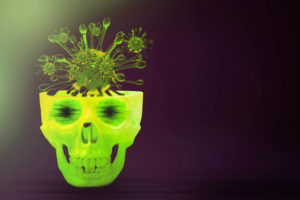Imagine a mother who can’t smell her daughter’s dirty diaper or finds her food tastes bland and loses a few pounds over a couple of weeks. Even without having any cough, fever, or shortness of breath, she could be exhibiting the signs of SARS-Cov2 infection without knowing it. In some people with mild COVID-19 like hers, there are no other respiratory or neurological issues.
In fact, mild neurological symptoms can be seen in up to 30-60% of patients with SARS-Cov2 infection. However, others are not so lucky and experience much more severe neurological problems such as stroke, seizures, confusion, dizziness, paralysis, and/or coma. One study from Wuhan, China, showed that 45% of patients with severe COVID-19 illness experience marked neurological deficits. Another study from France showed 84% of ICU patients with COVID-19 have positive abnormalities on their neurological examination.
In order to successfully treat COVID-19 patients who become confused, experience loss of consciousness and limb-shaking due to seizures, or suddenly can’t speak or walk, we need to explore the link between the virus and the damage to brain cells. To be effective, the treatment should target the underlying factor that is triggering their symptoms. For example, if a patient is disoriented and does not know what year it is, she would benefit from improving her lung function by killing the virus. However, if a patient suddenly experiences a stroke or a seizure due to a blood clot or too much inflammation in his brain, giving him medications that kill the virus would not stop his neurological symptoms.

Given that the pandemic of COVID-19 in recent weeks has overwhelmed the hospitals in cities around the world, physicians caring for these patients have focused more on keeping them alive – and less on finding effective treatment strategies for their neurological symptoms (which can be less urgent than their struggle to breathe and stay alive). After all, no double-blind clinical trials have been conducted to figure out how best we should treat stroke and/or confusion in these patients.
Being contagious is another factor that has limited the evaluation and reporting of neurological findings in COVID-19 patients. Special measures to protect the health care team and to limit the extent of infection in the hospital make it cumbersome to transport these patients (some of whom may be on ventilators) to the imaging center of the hospital and/or perform electrodiagnostic studies on them.
Despite these limitations, a dozen case reports and anecdotal findings are painting a sketch of what may be going on inside the brains of patients with COVID-19 infection.
Direct infection of the brain by this virus, traveling from the nose to the brain, is a possibility in some patients. A 24-year-old man in Japan who presented to ER with seizures and headaches, and whose brain imaging showed evidence of inflammation in the outer linings of his brain, had a positive test for SARS-Cov2 in his cerebrospinal fluid. However, the analysis of cerebrospinal fluid in seven ICU patients in France, published in NEJM, did not find any trace of SARS-Cov2. In yet another case report of five COVID-19 patients in ICU in Italy with paralysis of arms and legs (in a neurological condition called Guillian-Barre Syndrome), there was no trace of the virus in the cerebrospinal fluid. Finally, in yet another case report of an elderly man in Boca Raton, Florida, who presented with seizures, there was no evidence of this virus in the cerebrospinal fluid either.
While we are waiting to see larger size studies with consistent testing and reporting, we need to keep in mind that the failure to find SARS-Cov2 in the cerebrospinal fluid does not necessarily mean this virus does not exist in the brain. The common tests used to search for this virus in the blood may not work well to search for it in the fluid that surrounds the brain. More specific testing may be needed for finding SARS-Cov2 in the cerebrospinal fluid.
Given the reported findings in the Japanese man with a seizure, we need to assume SARS-Cov2 does have the capacity to gain access to the brain – at least in some patients. In fact, it remains conceivable that in some patients who die, SARS-Cov2 travels to the brain areas that are critical for breathing regulation, and it is the death of neurons in this control center for breathing that makes them stop breathing and die.

There is more compelling evidence to support the possibility for indirect pathways through which SARS-Cov2 triggers a wide variety of neurological disorders. This virus is known for its ability to trigger a flood of inflammatory markers which begin in the lungs and travel throughout all our body organs. This “cytokine storm” can injure the protective lining inside the blood vessels in the brain (called Blood-Brain Barrier, or BBB) that usually guards the brain cells against the toxic molecules in our blood.

Once this strong insulation inside the blood vessels in the brain is damaged, blood molecules leak into the brain and literally kill all the brain cells in their path. The blood vessels in the parts of the brain near our ears, called temporal lobes, do not have the best BBB to begin with. And so there is no surprise that these parts of the brain, which happen to be critical for our memory, learning, and language get destroyed first. This devastating process of neuronal death is called acute necrotizing hemorrhagic encephalitis and can be seen in a brain MRI – as was reported in an airline worker in Detroit with COVID-19 who presented to ER with confusion, cough, and fever.
The unwelcome flood of inflammatory molecules into the brain can also alter the balance of ions which under normal circumstances keep brain cells firing in a regular rhythm. The messy flood of ions, in turn, makes neurons prone to having an irregular rhythmic activity that results in different forms of seizures, from the usual form seen in movies (that consists of someone falling to the ground, drooling from their mouth, rolling up their eyes, and jerking their arms uncontrollably) to staring into space or appearing lost and confused for a few minutes to a few hours or days (as could happen in ICU patients who become confused for a long time).
Needless to say, some ICU patients may be disoriented and confused due to lack of oxygen, taking many medications, and having problems with multiple organs such as lungs, liver, kidney, and heart at the same time. Nevertheless, ICU physicians are familiar with the routine type of confused mentation in their patients and find that COVID-19 patients have nerve and brain problems above and beyond their typical patients. Many of these patients also have a stroke, paralysis, and seizures at a rate that is far more frequent than would be expected in a typical ICU population of patients.
The recent NEJM report with MRIs of ICU patients with severe COVID-19 illness demonstrates the variety of the problems this virus can cause in the brain. Some of these MRIs show findings that are consistent with overwhelming inflammation in and around the brain (due to breakdown of BBB). Some of them show evidence of small strokes deep inside the brain. Such small strokes are usually due to blood clots, as it can happen in patients with “vascular risk factors” such as high cholesterol, obesity, diabetes, sleep apnea, or hypertension.
But how could small strokes happen in otherwise healthy COVID-19 patients who do not have vascular risk factors?
It turns out that the cytokine storm in the lungs can activate the molecules in the blood that trigger the formation of blood clots. Besides blood cells, our bloodstream contains coagulation molecules that get activated when we cut our skin or if we have a nosebleed. This coagulation system protects us from excessive bleeding through a cut or a nosebleed by clotting the blood right away. However, when this system is activated artificially by a cytokine storm, blood clots are formed in the bloodstream which can then travel to different body organs, jam up their blood vessels, and deprive their cells of oxygen; in the heart, this causes a heart attack.
Hypercoagulation due to cytokine storms may cause problems in the kidney, liver, intestines, lungs, and brain.
In patients with moderate to severe COVID-19, the lungs are carpeted by a flood of tiny blood clots which prevent the transfer of oxygen molecules from air into our bloodstream. These same blood clots can travel to the brain, find their way into tapering branches of blood vessels, and block them. In this situation, the BBB remains intact but the blood flow through normal blood vessels is jammed – which then causes the stroke we see on patients’ MRI.
Since these strokes are small, it is possible that many patients with COVID-19 would have no noticeable neurological symptoms – unless these strokes happen in “eloquent” parts of their brain for tasks such as speaking, walking, or moving their hands. Most patients would not notice even 10-20 such tiny strokes if they happen in their brain areas for the appreciation of art or for making decisions.
Peppering of the brain with small strokes can account for a wide range of neurological issues after a patient recovers from their respiratory symptoms and leave the ICU. Recovered patients may have persistent memory loss, fatigue, difficulty processing information, or do simple math; many of them may not be able to keep up with their job responsibilities. These patients would never know they have had lots of small strokes unless their physician orders a brain MRI. Their compromised brain function would be similar to those who suffer from post-concussion syndrome for many months to years.
COVID-19 and the Heart
In COVID-19 patients, blood clots are found in the small vessels of all organs, including the heart, liver, and kidney, as reported in a webinar co-sponsored by the Chinese Cardiovascular Association and American College of Cardiology. A study in Lancet showed 12% of patients with COVID-19 have cardiac complications. These findings may explain the unexpected rise in recent months in the number of otherwise healthy patients who present to emergency rooms with chest pain and heart attacks.
In New York, the epicenter of COVID-19 in the US, there was a three-fold increase in the number of 911 calls for cardiac arrests between March 5th, 2020 to April 5th, 2020, as compared to the same period in 2019 (195 cardiac arrests in 2020 vs 65 in 2019). The sudden cardiac arrhythmia and other heart symptoms in many of these patients may have been due to COVID-19.

Physicians in emergency rooms now need to be mindful of the fact that some patients with chest pain may be suffering from blood clots triggered by COVID-19’s cytokine storm. One recent case report suggests that these patients, such as an otherwise healthy man in his 40s can benefit from blood-busting medications that are routinely given to patients with stroke or heart attacks (who are typically older and have obesity, diabetes, sleep apnea, and/or hypertension). The apparent effectiveness of thinning the blood in these patients supports the idea that blood clots are the culprit for their cardiac symptoms. In the above webinar, Dr. Junbo Ge, MD, president of the Chinese Cardiovascular Association and ACC China chapter governor, recommends treatment with anticoagulation in COVID-19 patients who have a high level of a blood marker for blood clots (D-dimer).
To complicate matters, a recent case report describes a patient with COVID-19 who presents to a hospital with typical symptoms of a heart attack, and yet his workup shows no evidence of a blockage in his cardiac arteries. His cardiac angiography revealed open blood vessels and no sign of cholesterol plaques. As such, he did not receive clot-busting medications such as tPA. Instead, he received steroid treatment to reduce the level of inflammation in his heart muscles (called myocarditis) along with supportive medications to keep his heart pumping. This approach to target the cytokine storm, and not the blood clots, worked. His heart which was pumping at a critically low level at 27% reached a normal level of 66% after his treatment.
There is a possibility that the SARS-Cov2 virus itself can trigger inflammation in the heart, even without a cytokine storm. This virus enters the cells via a protein called Angiotensin Converting Enzyme 2 receptor (ACE-2 receptor). The levels of this docking protein to ease the entry of the virus into the body is highest in the lungs and the heart.
Dr. Hamid Taheri, a cardiologist in Northern Virginia, has also treated many patients who present with typical symptoms of chest pain, EKG changes, and biomarker abnormalities in their blood (which are suggestive of myocardial infarction), and whose workup shows no evidence of occluded blood vessel. Dr. Taheri thinks, “this has created a dilemma in the cardiology community on how to approach and treat patients presenting with a heart attack and unknown COVID-19 status.” Many patients with COVID-19 can have heart (or neurological) symptoms without a fever, cough, and difficulty breathing. Should physicians in the ER who care for patients presenting with signs of a heart attack do a COVID-19 test on them first? And if positive, should they treat these patients differently? The answer is not known yet.
The current big picture for cardiologists is that cytokine storm causes a variety of heart-related complications which includes a flood of inflammation that destroys the heart muscle cells (myocarditis), a series of blood clots that can block the heart arteries (heart attacks), or change the balance of ions that in turn triggers irregular heart rate (cardiac arrest), and/or all of the above. In rare cases, the SARS-Cov2 virus may damage the heart directly.
Putting it All Together: How COVID-19 Ravages the Brain
Clearly, a lot more studies are needed before we can fully understand how SARS-Cov2 affects our nervous system. Once a clear picture emerges, and only then, we can determine which treatment interventions have the highest likelihood for success in COVID-19 patients with neurological symptoms.
For now, it appears that increasing severity of cytokine storm may lead to a flood of small blood clots that cause a series of small strokes in the brain as well as progressive damage to the protective layer inside blood vessels in the brain (BBB). Leakage of blood components into the brain kills neurons – particularly in brain regions that are important for learning and memory. In rare and latest stages of COVID-19 infection, the virus particles themselves may invade the brain directly, including the brain region that controls breathing.
Given these preliminary findings of the link between COVID-19 and neurological symptoms, drugs that can thin the blood and drugs that can reduce a load of cytokine storm in the blood should be particularly promising.
But first, we need to find out a way to determine which patient is having a stroke due to a small blood clot (such as a patient who suddenly cannot speak or cannot move his/her right hand) and which patient is experiencing leakage of BBB in his brain (such as a patient who is generally confused, lethargic, or is going into a coma). A combination of a brain MRI and performing a lumbar puncture, which can look for the evidence of inflammation and virus itself in the cerebrospinal fluid, may prove quite helpful. Patients who have blood clots in their brain and show signs of stroke would benefit from immediate treatment with clot-busting medications such as tPA. Patients who have BBB damage and encephalitis may benefit from drugs that block cytokines and reduce inflammation.
We are clearly in the early stages of appreciating what tests need to be done and what treatments may be more effective for individual COVID-19 patients. Some of the effects of COVID-19 in the brain, such as multiple strokes, may cause long-term problems for patients such as memory loss, low cognitive stamina, and difficulty keeping up with life’s day-to-day tasks. Such patients need careful assessment and long-term brain rehabilitations.
Needless to say, patients with severe encephalopathy will need immediate treatment in ICU. There is a pressing need to conduct studies that confirm the mechanisms through which SARS-Cov2 destroys the brain in ICU patients. We need answers quickly as thousands of patients are experiencing irreversible brain damage or die every day due to COVID-19.

Learn more about how your brain works. Check out NeuroGrow’s 12-week brain fitness program.
Medical Director, NeuroGrow Brain Fitness Center
Affiliate Staff, Johns Hopkins Medicine



